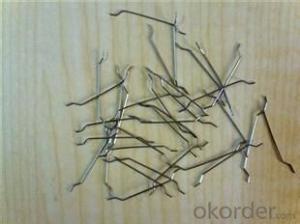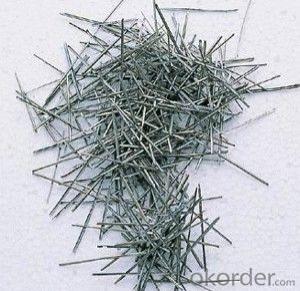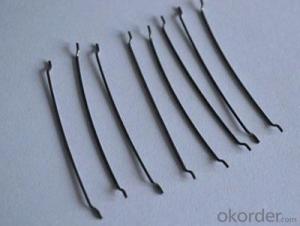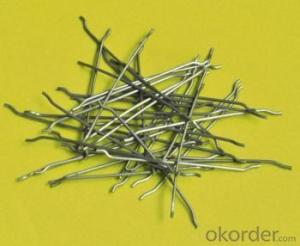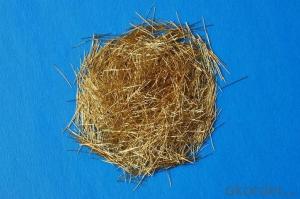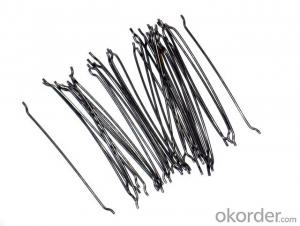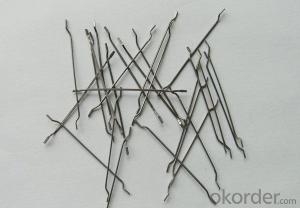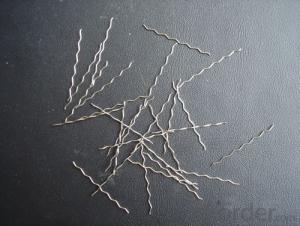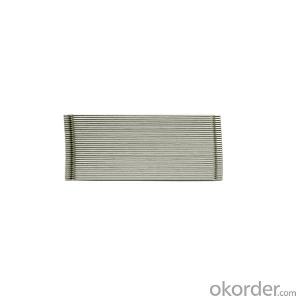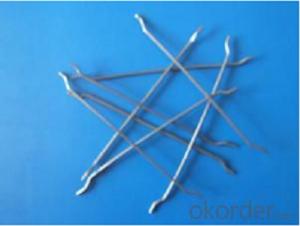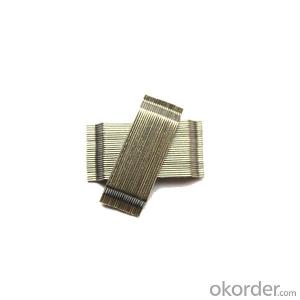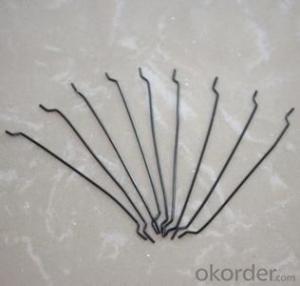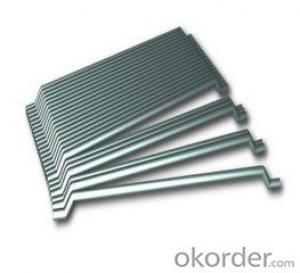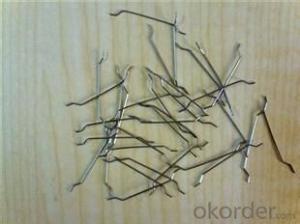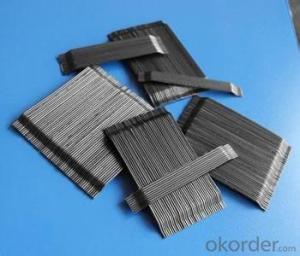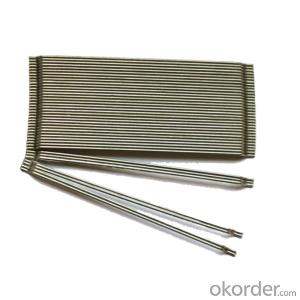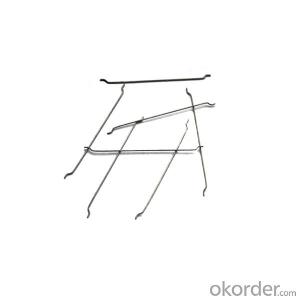Melt Extract Stainless Steel Fiber 0.9/50 Concrete Steel Fiber from CNBM China
- Loading Port:
- Tianjin
- Payment Terms:
- TT OR LC
- Min Order Qty:
- 1 m.t.
- Supply Capability:
- 5000 m.t./month
OKorder Service Pledge
Quality Product, Order Online Tracking, Timely Delivery
OKorder Financial Service
Credit Rating, Credit Services, Credit Purchasing
You Might Also Like
Quick Details
Place of Origin: Tianjin, China (Mainland)
Model Number: 0.9
Material: Steel
Production Process: Cold drawn
Lengh: 50
Type: 1
Compressive Strength: >1200MPa
Aspect ratio: 56
Standard: ASTM A820M-11
Section Shape: Circular
Application: Concrete Reinforcement
Packaging & Delivery
| Packaging Details: | 20 kg/Bag,50 bags/Pallet or 1,000kg/ Bulk Bag |
|---|---|
| Delivery Detail: | 1 Month |
Product Description
| Diameter | 0.90 | mm | 0.04 | in |
| Length | 50.00 | mm | 1.96 | in |
| Aspect Ratio | 56 | |||
| Tensile strength | 1200 MPa | |||
| Type | Cold drawn Steel Fiber | |||
| End | Hooked-end Steel Fiber | |||
| Glued/Loose | Glued Steel Fiber | |||
| Bending Angle | 45°(min.30°) | |||
| Usage & Performance | Floor:Trafficked areas and Industrial floors | |||
| Shotcrete :Slope stabilization and Final lining | ||||
| Precast concrete:Pipe and Railway sleepers | ||||
| Packing | Standard Export Pallet Packing | Bag Packing | 20 kg/Bag,50 bags/Pallet | |
| Bulk Packing | 1,000kg/ Bulk Bag | |||
| Loading Quantity | 20’GP | 20-25 Tonne/Tonnes | ||
| 40’GP | 25-27 Tonne/Tonnes | |||
| 40’HQ | 25-27 Tonne/Tonnes | |||
| MOQ | 1 kg for trial order | |||
| Supply Ability | 10,000 Tonne/Tonnes per Year | |||
| Payment Terms | T/T or L/C at sight | |||
| Delivery Time | Within 15 days after receiving deposit or original L/C at sight | |||
| Certification | ISO9001:2000, CE, | |||
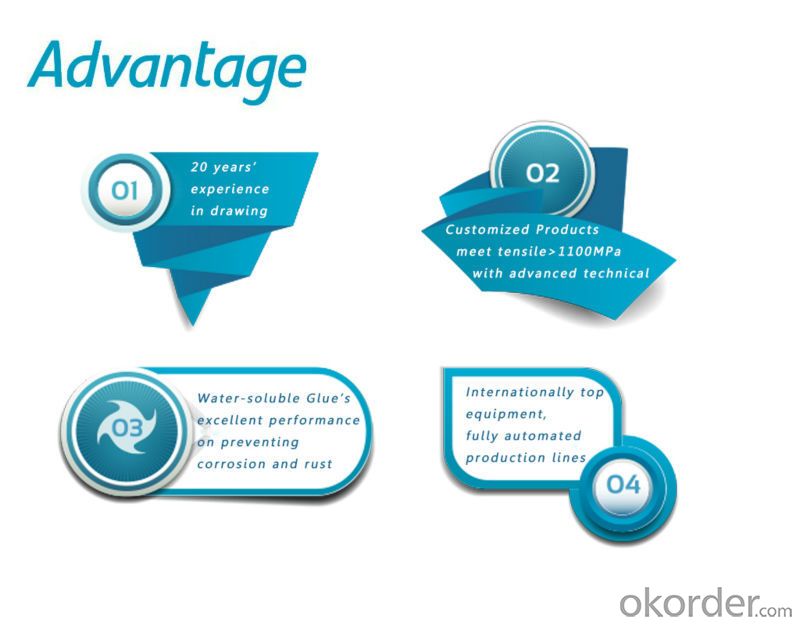
| Product | Diameter | Length mm/in | Aspect Ratio | Type | Packing |
| G-6030 | 0.5 mm (0.0197 in) | 30 mm (1.1811 in) | 60 | Glued | 20 kg/Bag, or 1,000kg/ Bulk Bag |
| G-6535 | 0.55 mm (0.0217 in) | 35 mm (1.3780 in) | 65 | Glued | 20 kg/Bag, or 1,000kg/ Bulk Bag |
| G-6035 | 0.6 mm (0.0236 in) | 35 mm (1.3780 in) | 60 | Glued | 20 kg/Bag, or 1,000kg/ Bulk Bag |
| G-8060 | 0.75 mm (0.0295 in) | 60 mm (2.3622 in) | 80 | Glued | 20 kg/Bag, 50 bags/Pallet |
| G-6060 | 0.9 mm (0.0354 in) | 60 mm (2.3622 in) | 60 | Glued | 20 kg/Bag, 50 bags/Pallet |
| G-6030 | 0.5 mm (0.0197 in) | 30 mm (1.1811 in) | 60 | Loose | 20 kg/Bag, or 1,000kg/ Bulk Bag |
| G-6535 | 0.55 mm (0.0217 in) | 35 mm (1.3780 in) | 65 | Loose | 20 kg/Bag, or 1,000kg/ Bulk Bag |
| G-6035 | 0.6 mm (0.0236 in) | 35 mm (1.3780 in) | 60 | Loose | 20 kg/Bag, or 1,000kg/ Bulk Bag |
| G-8060 | 0.75 mm (0.0295 in) | 60 mm (2.3622 in) | 80 | Loose | 20 kg/Bag, 50 bags/Pallet |
| G-6060 | 0.9 mm (0.0354 in) | 60 mm (2.3622 in) | 60 | Loose | 20 kg/Bag, 50 bags/Pallet |
- Q: Can melt extract stainless steel fiber be used in tunnel shotcrete lining applications?
- Absolutely, tunnel shotcrete lining applications can utilize melt extract stainless steel fiber. This particular fiber is widely employed to augment the mechanical characteristics of shotcrete, including tensile strength, flexural strength, and impact resistance. Moreover, the inclusion of melt extract stainless steel fibers can elevate the durability and longevity of shotcrete, rendering it ideal for tunnel applications where sustained performance is of utmost importance. Typically, these fibers are blended into the shotcrete mixture, thereby strengthening the overall structural integrity of the tunnel lining. All in all, melt extract stainless steel fibers present a dependable and efficient option for reinforcing tunnel shotcrete linings.
- Q: What is the effect of melt extract stainless steel fiber on the deflection of concrete slabs?
- The effect of melt extract stainless steel fiber on the deflection of concrete slabs is generally positive. The incorporation of stainless steel fibers in concrete slabs helps to enhance their flexural and structural properties, resulting in reduced deflection. Stainless steel fibers act as reinforcement within the concrete matrix, improving its tensile strength and crack resistance. When subjected to external loads or forces, the fibers distribute the stress more evenly throughout the slab, reducing the likelihood of excessive deflection or failure. This is particularly beneficial in applications where the concrete slabs are subjected to heavy loads or dynamic forces, such as in industrial or high-traffic areas. Additionally, the use of melt extract stainless steel fibers in concrete slabs can also enhance their overall durability and lifespan. The fibers provide an additional layer of protection against cracking and deterioration, resulting in a longer service life for the slabs. It is worth noting that the effect of melt extract stainless steel fiber on deflection also depends on other factors such as the fiber content, aspect ratio, and distribution within the concrete mix. Proper design and dosage of the fibers should be considered to achieve the desired effect on deflection control. In conclusion, incorporating melt extract stainless steel fibers in concrete slabs has a positive effect on their deflection. The fibers improve the flexural and structural properties of the concrete, reducing deflection and enhancing overall durability. Proper design and dosage of the fibers are crucial to ensure optimal results.
- Q: How does melt extract stainless steel fiber improve the resistance to fatigue in shotcrete?
- Melt extract stainless steel fiber improves the resistance to fatigue in shotcrete by increasing the structural integrity and durability of the material. The fibers act as reinforcement, enhancing the tensile strength and preventing crack propagation, ultimately reducing the likelihood of fatigue failure.
- Q: What is the effect of melt extract stainless steel fiber on the fatigue life of asphalt mixtures?
- Incorporating melt extract stainless steel fibers into asphalt mixtures yields positive outcomes for the material's fatigue life. The purpose of adding these fibers is to enhance the mechanical properties of the asphalt mixtures and enhance their performance in repeated loading scenarios. The inclusion of stainless steel fibers in asphalt mixtures aids in bolstering resistance to fatigue cracking. Fatigue cracking is a common issue in asphalt pavements, particularly in areas with heavy traffic, as continuous vehicle loading weakens the material and causes it to crack eventually. Through the integration of stainless steel fibers, the asphalt mixture becomes more resilient, allowing it to endure higher levels of stress without developing cracks. The stainless steel fibers serve as reinforcement within the asphalt matrix, lending additional strength and improving material cohesion. This reinforcement effectively distributes the load evenly across the pavement, reducing stress concentration in specific areas and minimizing the formation of fatigue cracks. Moreover, the presence of stainless steel fibers in the asphalt mixture enhances its resistance to permanent deformation or rutting. Rutting occurs when the asphalt material deforms and permanently shifts under repeated traffic loads. The fibers play a crucial role in stabilizing the asphalt matrix, thereby preventing excessive deformation and maintaining the structural integrity of the pavement. Overall, the incorporation of melt extract stainless steel fibers into asphalt mixtures significantly improves the material's fatigue life. It enhances resistance to fatigue cracking and rutting, resulting in longer-lasting and more durable asphalt pavements. This can lead to reduced maintenance and repair costs, as well as enhanced safety and comfort for road users.
- Q: Is melt extract stainless steel fiber compatible with different types of aggregates?
- Different types of aggregates are compatible with melt extract stainless steel fiber. In concrete, stainless steel fiber is often utilized as a reinforcing material to strengthen its tensile strength, durability, and resistance to cracking. It can be combined with various aggregates including sand, gravel, crushed stone, or recycled materials without compromising compatibility. The concrete mixture is evenly infused with these fibers, leading to enhanced overall performance and prevention of crack formation. Furthermore, the stainless steel fibers exhibit no chemical reactions with the aggregates, thus guaranteeing long-term stability and compatibility.
- Q: Can melt extract stainless steel fiber be used in parking lot pavements?
- Indeed, melt extract stainless steel fiber is applicable for utilization in parking lot pavements. It is a prevalent practice to employ stainless steel fibers as reinforcement in concrete, thereby enhancing its robustness, endurance, and resistance to fractures. Considering the substantial loads and frequent traffic endured by parking lot pavements, the inclusion of stainless steel fibers can significantly augment the pavement's overall performance and lifespan. These fibers function as reinforcements, effectively dispersing stresses and impeding the creation and spread of cracks. Consequently, this can minimize the necessity for maintenance and elongate the pavement's existence, rendering it a judicious and cost-efficient selection for parking lot construction.
- Q: What is the effect of melt extract stainless steel fiber on the fire resistance of concrete?
- The addition of melt extract stainless steel fiber to concrete has a significant effect on the fire resistance of the material. Stainless steel fibers are known for their high melting point and excellent heat resistance properties. When incorporated into concrete, these fibers provide enhanced fire resistance by improving the material's overall thermal conductivity and reducing the risk of spalling, cracking, or structural failure during a fire event. The stainless steel fibers act as reinforcement within the concrete matrix, increasing its tensile strength and preventing the propagation of cracks caused by thermal expansion and contraction. This reinforcement effect allows the concrete to maintain its structural integrity for a longer period of time under high temperatures. The presence of stainless steel fibers also helps to minimize the loss of strength and stiffness in concrete exposed to fire. This is achieved through the fibers' ability to withstand high temperatures without undergoing significant deformation or degradation. As a result, the concrete retains its load-bearing capacity and can better resist the effects of fire-induced stress. Furthermore, the use of melt extract stainless steel fibers can reduce the risk of spalling, which is a common phenomenon in concrete when exposed to fire. Spalling occurs when the outer layer of concrete is subjected to rapid heating, causing the evaporation of water trapped within the pores. The resulting steam pressure can lead to explosive spalling and loss of structural integrity. The steel fibers help to mitigate this by providing a reinforcement network that holds the concrete together, preventing the rapid release of steam and minimizing spalling. In summary, the incorporation of melt extract stainless steel fiber in concrete significantly improves its fire resistance by enhancing thermal conductivity, reducing spalling, increasing tensile strength, and maintaining structural integrity. These beneficial effects make it an effective solution for enhancing the fire performance of concrete structures, especially in high-risk fire scenarios.
- Q: Can melt extract stainless steel fiber be used in marine construction?
- Indeed, it is possible to utilize melt extract stainless steel fiber in marine construction. Due to its remarkable resistance against corrosion, stainless steel proves to be an appropriate material for marine settings that are exposed to high levels of saltwater, moisture, and other corrosive elements. By integrating melt extract stainless steel fiber into concrete or other building materials employed in marine construction, one can enhance their robustness, longevity, and resistance to corrosion. This, in turn, can extend the lifespan of marine structures and reduce the necessity for frequent maintenance and repairs. Furthermore, incorporating stainless steel fiber in marine construction can elevate the overall structural integrity and performance of the built environment in these demanding conditions.
- Q: What is the effect of melt extract stainless steel fiber on the durability of shotcrete?
- The use of melt extract stainless steel fiber in shotcrete can greatly enhance its durability. Shotcrete is a popular construction material that is typically sprayed onto surfaces, providing a strong and durable concrete layer. However, shotcrete can be prone to cracking and spalling over time, especially in harsh environmental conditions or under heavy loading. By incorporating melt extract stainless steel fiber into the shotcrete mix, the overall durability of the material is significantly improved. These fibers act as reinforcement, providing added strength and crack resistance to the shotcrete. The stainless steel fibers help to distribute stress and prevent the formation and propagation of cracks, thus enhancing the overall durability and lifespan of the shotcrete. The unique properties of melt extract stainless steel fibers make them ideal for shotcrete applications. They have high tensile strength, which allows them to effectively resist crack formation and propagation. Additionally, stainless steel fibers exhibit excellent corrosion resistance, even in aggressive environments, further enhancing the durability of the shotcrete. The addition of melt extract stainless steel fibers also improves the overall structural integrity of shotcrete. The fibers help to increase the flexural and shear strength of the material, making it more resistant to loading and impact forces. This enhanced structural integrity ensures that the shotcrete can withstand heavy loads, vibrations, and other external forces without significant damage or degradation. Overall, the incorporation of melt extract stainless steel fiber in shotcrete significantly improves its durability by enhancing crack resistance, corrosion resistance, and structural integrity. This results in a longer lifespan and reduced maintenance requirements for shotcrete structures, making it a highly beneficial addition to the construction industry.
- Q: How does melt extract stainless steel fiber improve the resistance of concrete to carbonation?
- The resistance of concrete to carbonation is improved by melt extract stainless steel fiber through various mechanisms. Firstly, the overall durability and longevity of concrete structures are enhanced by the addition of stainless steel fibers. These fibers act as reinforcement, increasing the tensile strength and crack resistance of the concrete matrix. In the case of carbonation, stainless steel fibers play a vital role in minimizing the ingress of carbon dioxide into the concrete. Carbonation occurs when carbon dioxide from the atmosphere reacts with calcium hydroxide in the concrete, resulting in the formation of calcium carbonate. This reaction causes a decrease in pH levels and the potential corrosion of steel reinforcement within the concrete. By incorporating melt extract stainless steel fibers, the concrete's resistance to carbonation is significantly improved. The fibers act as a physical barrier, hindering the diffusion of carbon dioxide into the concrete matrix. This helps to maintain higher pH levels, preventing the formation of calcium carbonate and subsequent corrosion. Furthermore, the stainless steel fibers also provide additional protection to the embedded steel reinforcement. If carbonation does occur and reaches the steel reinforcement, the presence of stainless steel fibers can help mitigate the effects of corrosion. Stainless steel is highly resistant to corrosion, even in highly alkaline environments, ensuring the structural integrity of the concrete. In conclusion, melt extract stainless steel fiber enhances the resistance of concrete to carbonation by improving its durability, acting as a physical barrier to carbon dioxide diffusion, maintaining higher pH levels, and providing protection to the steel reinforcement. These combined effects contribute to the long-term performance and sustainability of concrete structures, reducing maintenance costs and extending their service life.
Send your message to us
Melt Extract Stainless Steel Fiber 0.9/50 Concrete Steel Fiber from CNBM China
- Loading Port:
- Tianjin
- Payment Terms:
- TT OR LC
- Min Order Qty:
- 1 m.t.
- Supply Capability:
- 5000 m.t./month
OKorder Service Pledge
Quality Product, Order Online Tracking, Timely Delivery
OKorder Financial Service
Credit Rating, Credit Services, Credit Purchasing
Similar products
Hot products
Hot Searches
Related keywords
